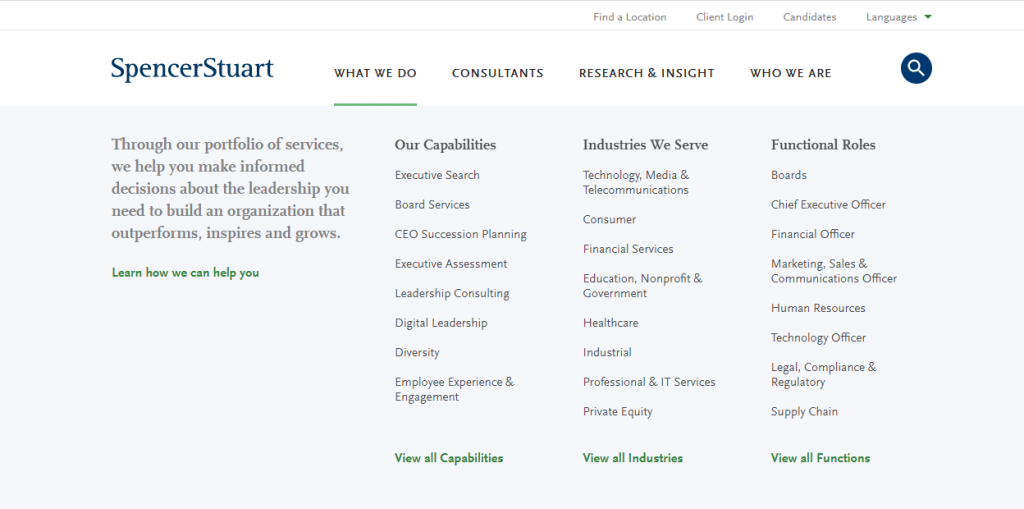The navigation menu, the small section that follows the company logo, seems simple, straightforward, and should therefore be easy to create. This design attribute that is deceptively simple, may look like a mere collection of links. But combined with business strategy and a deep understanding of how culturally- diverse users interact with websites, the simple navigation menu becomes an important web design attribute that encourages website engagement that is intuitive for global visitors.
Our research of 50 global executive search websites revealed that even the biggest firms in the industry have created navigation menus that could intimidate a global audience. While it is important for global hiring managers to get the impression of the intensity and depth of information available on the website, it is more important to have them feel confident to engage with the website to find solutions to their problems.
Global search firms tend to have a ‘fat’ navigation menu. What we mean is that it offers a wide variety of links arranged in multiple drop-down options that lead to different pages on the website. While many web designers may argue that more links in the main navigation create more opportunities to engage with the website, it can actually lead to confusion – the paradox of choice.
A research study revealed that users from low-certainty avoidance cultures (basically people who view that risk and risk-taking are acceptable means for obtaining greater gains in all areas of life) tend to prefer less control in the navigation experience. Here, web designers can create intrigue and interest with just the important details, leaving any other additional information for later that may not be as relevant to make a decision as with the case of users from high-certainty avoidance cultures. These users are not willing to take a risk till they know every last detail of the services on offer.
Some examples of countries with low-certainty avoidance cultures are: Singapore, Denmark, Sweden, India, United States
And some examples of countries with high-certainty avoidance cultures are: Greece, Portugal, Russia, Japan, Argentina
If your executive search firm is relying on the primary URL to communicate its services for all countries, it offers a challenge to create a user experience that considers the cultural nuances of multiple groups. However, it is not impossible to achieve. Through an internationalized website design, a cross-cultural user experience ensures that it offers a culture-neutral experience, that doesn’t prioritize one culture over the other.
When it comes to creating a navigation menu that engages across all cultures, it is important to consider the following:
Keep the links intentional
Some top-level titles like About Us, Services, Consultants are non-negotiable as they have come to be expected of international executive search websites. Global hiring managers are in search of certain information about the firm, and the first place they will consider is the main navigation menu. Therefore, it is important to identify key links so that the menu can be kept short as well as offering a flat navigation experience (making all content links more discoverable at a glance with fewer sub-menu levels).
Keep it clean and appealing
Long lists in the sub-menu are a preferable way for users to explore what content is accessible, but it is important to present the sub-menu titles in a way that doesn’t disorient them. By planning categories and sub-titles, mega menu designs is a suitable design approach that keeps all embedded links visible at one glance. See figure 1. This way users can choose the category of interest, and quickly have access to sub-menu titles within two or three clicks.

Figure 1: Spencer Stuart has created an engaging mega-menu display for the sub-menu tiles for easy access.
Use simple language to describe the link titles
It can be tempting to use creative titles to describe top-level links, however, executive search firms need to remember that they are catering to a culturally diverse audience. These users may choose to interact with the website in the default language, which is English, or use translation tools to engage with the website in their own language.
If the user sticks to the default language, it may take them a little longer to grasp the title headings. This experience can also give them the impression that the website is catering to a certain cultural group based on the choice of words more popular with other cultures. If they decide to switch to translation tools, they may not get accurate translations from English to their language. This experience can force them to exit the website, taking with them the wrong impression about the search firm.
Design to enable readability
For a culturally diverse audience making the attempt to engage with an English website, it helps to make it simpler by choosing easy-to-read fonts, fonts that can be translated, and even paying attention to color contrast pairings. This not only supports readability but also helps the user to navigate quickly, helping them reach the desired information intuitively.
Responsive menu design
With menu navigation that is two or three-tiered, it is important that they can be adapted to various screen sizes. In some countries like India, users rely on their mobile phones during long commute times between home and office. Not paying attention to the responsiveness of the site is excluding a large percentage of website visitors.
Potential to scale
Executive search firms planning to scale in new markets, diversify their services, or add new industries and functions should have a website design that can scale to accommodate these upgrades naturally. With a website planned well, the navigation menu can include other important attributes like the search bar, global gateway menu for location or language options, client/candidate/employee login links etc. Since visitors from high-certainty avoidance cultures prefer more reading links and additional information options, it is then important that these resources are available on the website in familiar places.
By not planning for them, the navigation menu could either disorient users or seem incomplete of certain features, when in all likelihood it is present but just not placed in a visible or accessible area. Some examples are highlighted in the 2021 Global-Ready Websites Report, where certain links and navigation attributes haven’t been placed optimally for a culturally diverse audience.
To summarize, executive search firms that are just getting started with global expansion, and keen to offer customer-centric user experiences can do so with the help of an internationalized website as a starting point. This means that by offering a cross-cultural user experience, your website welcomes all visitors, and helps them navigate seamlessly across the website. With a navigation menu designed for a global audience, keeping their cultural nuances in mind, executive search firms can demonstrate their global focus.
To find out how other web design attributes support global executive search firms, click here. Remove the guesswork and focus on only those web design features that have come to be expected and relevant for global search firms looking to expand or establish their footprint in overseas markets.






